My Ball-of-Light Particle Model -- a working grand unification theory -- predicts that elementary particles are spherical "standing" waves of electric, magnetic, and gravitational fields. It predicts that on the surface of the elementary particle is a pattern of "patches" of fields. An example of one of my early graphics that I used to show this idea is repeated below:
I have called this a "harmonic core" in the past. (See also, Decay Modes, Eta Carinae, Gravitational Induction of an electromagnetic Wave, Harmonic Patterns--page 3) Mathematically, this example of a harmonic sphere is not correct. Notice how the shape of each patch is not identical and how they get smaller towards the poles. While I explained that the patches must be of equal size, be symmetrical, and have the same shape, I did not demonstrate the concept very well with this graphic. The example I used for a nonharmonic particle is shown below:
Indeed this is a nonharmonic particle, but it too did not convey the meaning I had intended.
Platonic Bodies are regular polyhedrae. (Polyhedra -- A three dimensional object bounded by polygons, with each edge shared by exactly two polygons.) Euclid demonstrated that there are 5 Platonic Bodies:
| Name | Faces | Vertices | Edges |
|
| 1) Tetrahedron |
|
|
|
|
| 2) Hexahedron |
|
|
|
|
| 3) Octahedron |
|
|
|
|
| 4) Dodecahedron |
|
|
|
|
| 5) Icosahedron |
|
|
|
|
A Platonic Sphere is the smallest sphere that will enclose a Platonic Body (all vertices are on the surface of the sphere) where the faces of the Platonic Body are projected, or "mapped", onto the surface of the sphere. (For a better mathematical description see Platonic Spheres by Dr. Neubert. This page includes very nice 3D versions of Platonic Bodies and Platonic Spheres.)
| Name | Faces | Vertices | Edges |
| *) Sphere |
|
|
|
| **) Bisected Sphere |
|
|
|
| 1) Tetrahedral Sphere |
|
|
|
| 2) Hexahedral Sphere |
|
|
|
| 3) Octahedral Sphere |
|
|
|
| 4) Dodecahedral Sphere |
|
|
|
| 5) Icosahedral Sphere |
|
|
|
(*, ** are not Platonic Spheres)
Technically, a sphere -- with no mapped faces from a Platonic Body, with no edges -- is not a Platonic Sphere. I have included it here because it forms an important mathematical and geometric series related to the Ball-of-Light Particle Model not explained by Platonic Spheres.
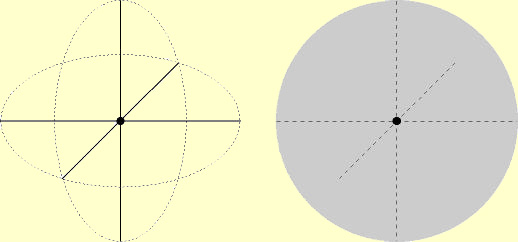
Sphere with no mapped faces.
In the Ball-of-Light Particle Model, a sphere with no mapped edges would be electromangetically neutral, 0 or 1 spin (e.g., a neutrino).
Technically, a bisected sphere -- with no mapped faces from a Platonic Body, with one edge -- is not a Platonic Sphere. I have included it here because it forms an important mathematical and geometric series related to the Ball-of-Light Particle Model not explained by Platonic Spheres.
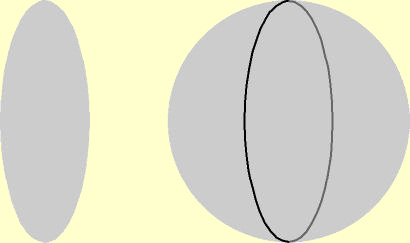
In the Ball-of-Light Particle Model, a bisected sphere would have 1/2 spin (e.g., an electron).
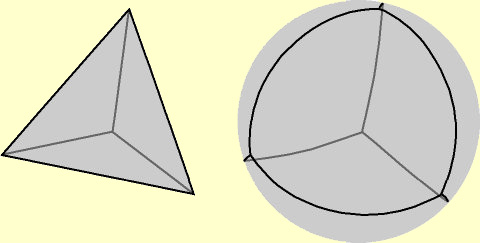
(On the left is a Tetrahedron and on the right is a Tetrahedral Sphere)
I think of each face as representing a half-wave originating from the opposite vertice.
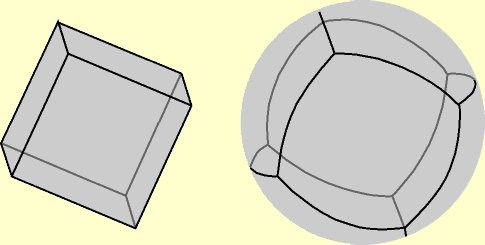
(On the left is a Hexahedron and on the right is a Hexahedral Sphere)
This does not appear to me as a likely harmonic particle.
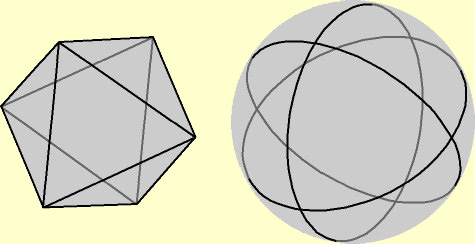
(On the left is an Octahedron and on the right is an Octahedral Sphere)
I especially like this geometric configuration because it is easy to point to the wave. Whenever the method of dissecting the sphere has circumferential lines -- forming to hemispheres -- it can obviously be related to a spherical wave.
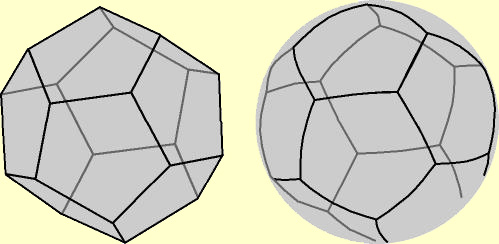
(On the left is a Dodecahedron and on the right is a Dodecahedral Sphere)
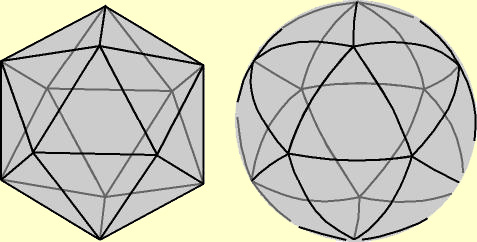
(On the left is an Icosahedron and on the right is an Icosahedral Sphere)
Supposedly, Descartes, and others, have proven that there are only 5 Platonic bodies. This is based upon the traditional definition of a Platonic Body. Obviously, there are 7 spheres in the above series -- but this would require a definition other than for Platonic Bodies if a point and a plane are to be included.
The Ball-of-Light Particle Model describes elementary particles such as neutrinos, electrons, neutrons and protons as spherical standing waves of electric, magnetic, and gravitational fields. Some particles, such as neutrinos, electrons, and protons are stable. Some particles, such as the neutrons, are not stable. It is my belief that the stability of the particle depends on how the electric and magnetic fields are aligned on the surface of the sphere. (Remember, the gravitational field points to the center of the sphere and is the cross product of the electric and magnetic field. Therefore, for our purposes here, we may ignore the gravitational field and concern ourselves with just the electric and magnetic waves.)
A spherical wave can be defined by the intersection of a sphere and a cone. (The cone is defined to have its vertex at the center of the sphere.) The two key parameters are the radius of the sphere and the angle of the cone. This can be visualized with the following animation:
Cone Sweeping Over Sphere
To simplify this animation, I did not have the cone converge to a point at each pole, and I did not show the intersection of the cone and sphere. The following animation is similar, showing the intersection of a slab passing through a sphere.
To correctly visualize these animations from a mathematical point of view, you need to imagine the dimensions where the cone's thickness delta t, and the sphere's thickness delta r, approach the limits of zero, that is, dt and dr.
Finally, let me remind you that you must imagine the superposition of separate waves. My model of a photon is a spherical moving wave. My model for a neutron is two photons, with exactly the same wavelength and polarization, moving in the opposite directions, combining to create a standing wave. My model of an electron is to throw an extra wave on top of a neutron. By superimposing wave after wave, with quantum after quantum of energy, in a compatible pattern, I believe you can build larger and larger particles, with greater and greater energy. All I am trying to address here is, What is a "compatible pattern?"
While there are only 5 classic Platonic Spheres, I believe there are many other spherical polyhedron (infinite?) that could represent the electromagnetic and gravitational fields on elementary particles. Take for example the Rhombicosacron:
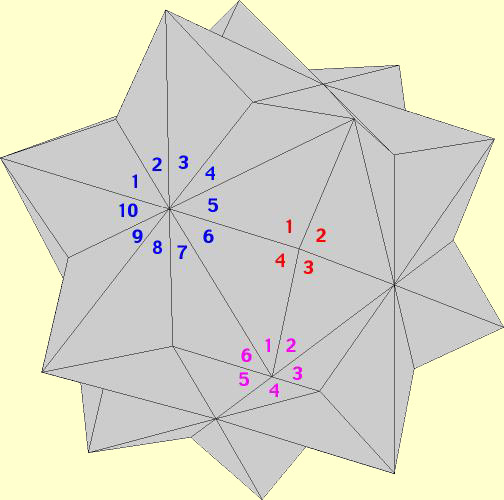
Rhombicosacron
The Rhombicosacron has 60 faces, 50 vertices and 120 edges. The most important detail of this object is, if you follow any edge, it forms a straight line completely around the object -- it defines a plane that passes through the center of the object. One of the key differences between an object like this one and a Platonic Body is that all of the vertices will not be on the encompassing sphere. (Of course, all of the unique external points of the object -- including the vertices -- can be mapped to unique points on the sphere.) Another key difference between this object and a Platonic Body is the mapped areas are not symmetrical and of the same shape. For example, the triangles on the Icosahedron are all of the same size and shape. Each edge of a triangle has the same length. The triangular faces on the Rhombicosacron have segments that are not of the same length -- with angles that are not congruent. Finally I would like to point out that there are three types of vertices on this body: 2 line, 3 line and 5 line. (Note 2, 3 and 5 are primes.) These lines make vertices with: 4 faces, 6 faces and 10 faces. (My intuition tells me the Rhombicosacron -- mapped onto a sphere -- would be a quasi-stable particle that would probably decay into 2 or more other more stable particles, like a neutron.)
In order to better understand the significance of a symmetrical non-Platonic body like this, let us compare it with another less symmetrical body called the Pentakisdodecahedron:
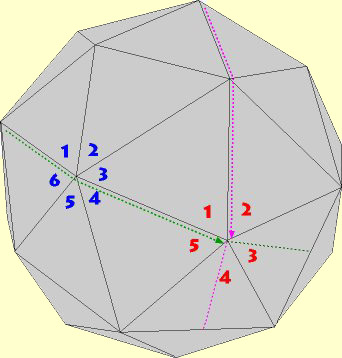
Pentakisdodecahedron
First, notice that if you follow a line, like the green line, or the magenta line, you will see that it ends at the vertice. You can not follow the line completely around the object. While the pentagram defined by the red faces numbered 1 - 5 is an interesting and beautiful geometric shape, it does not appear -- at least to me -- to be compatible with defining a harmonic electromagnetic and gravitational wave on a sphere. Both numbered vertices appear geometrical or mathematically symmetrical when analyzed independently, but do not combine to form electromagnetic symmetry on the particle. This restriction seems even rule out most of the Platonic solids as stable particles.
Recently, I came across a great website on polyhedra by Vladimir Bulatov. His website has VRLM versions of hundreds, maybe thousands of polyhedra. If you have read this page this far I can see no reason why you wouldn't love his images and graphics -- go check it out.
The following link is great for visualizing Platonic Spheres:
The following links are great examples of non Platonic polyhedra that if mapped onto a sphere would make possible harmonic balls-of-light:
Small Icosacronic Hexecontahedron
Small Dodecacronic Hexecontahedron
This link is great for visualizing combining the waves of two balls-of-light even though all of the examples would not apply.
Compounds of Uniform Polyhedra
The following link reminds me of the cells on the surface of the sun:
And finally, check out Polyhedral Mirrors.
See also Sunspot Seething, The Sun Oscillates, The Sun's Surface in 3D, and The Sharpest View of the Sun.